

The Data Access Object (DAO) Design Pattern. In this post, we'll see the basic of DAO Design Pattern, how to implement and what advantages it provide and it's use.
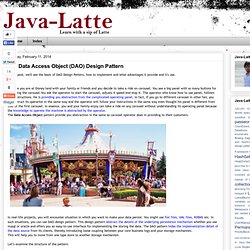
Suppose you are at Disney land with your family or friends and you decide to take a ride on carousel. You see a big panel with so many buttons for operating the carousel.You ask the operator to start the carousel, adjusts it speed and stop it. The operator who know how to use panel, follows your instructions. He is providing you abstraction from the complicated operating panel. In fact, if you go to different carousel in other fair, you can instruct its operartor in the same way and the operator will follow your instructions in the same way even thought his panel is different from that of the first carousel. The Data Access Object pattern provide you abstraction in the same as carousel operator does in providing to their customers. In real-life projects, you will encounter situation in which you want to make your data persist. Let’s examine the structure of the pattern. Codefutures. CodeFutures offers an effective sharding solution with our product, dbShards.

Our customers have used dbShards to achieve unprecedented performance, in the scope of hundreds of millions of reads and millions of writes every day. Best Practice Software Engineering - Data Access Object. One aspect of the business layer is the data access layer that connects the services with the database.

Accessing data varies depending on the source of the data. Access to persistent data varies greatly depending on the type of storage (database, flat files, xml files, and so on) and it even differs from its implementation (for example different SQL-dialects). The goal is to abstract and encapsulate all access to the data and provide an interface. This is called the Data Access Object pattern. In a nutshell, the DAO "knows" which data source (that could be a database, a flat file or even a WebService) to connect to and is specific for this data source (e.g. a OracleDAO might use oracle-specific data types, a WebServiceDAO might parse the incoming and outgoing message etc.).
From the applications point of view, it makes no difference when it accesses a relational database or parses xml files (using a DAO). Java - DAO design pattern. Database Interaction with DAO and DTO Design Patterns. We Recommend These Resources.
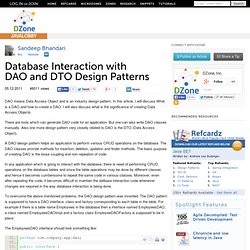
Core J2EE Patterns - Data Access Object. Context Access to data varies depending on the source of the data.

Access to persistent storage, such as to a database, varies greatly depending on the type of storage (relational databases, object-oriented databases, flat files, and so forth) and the vendor implementation. Problem Many real-world Java 2 Platform, Enterprise Edition (J2EE) applications need to use persistent data at some point. For many applications, persistent storage is implemented with different mechanisms, and there are marked differences in the APIs used to access these different persistent storage mechanisms. Typically, applications use shared distributed components such as entity beans to represent persistent data. Applications can use the JDBC API to access data residing in a relational database management system (RDBMS). There is even greater variation with different types of persistent storage. Forces. Data Access Object Pattern. Data Access Object (DAO) design pattern in Java - Tutorial Example.
Data Access Object or DAO design pattern is a popular design pattern to implement persistence layer of Java application.
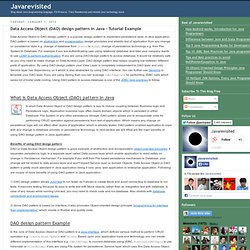
DAO pattern is based on abstraction and encapsulation design principles and shields rest of application from any change on persistence layer e.g. change of database from Oracle to MySQL, change of persistence technology e.g. from File System to Database. For example if you are authenticating user using relational database and later your company wants to use LDAP to perform authentication. If you are using DAO design pattern to access database, it would be relatively safe as you only need to make change on Data Access Layer. DAO design pattern also keeps coupling low between different parts of application. Data Access object (DAO) Design Pattern. Share on Google+ Data Access object (DAO) Design PatternPosted on: October 26, 2010 at 12:00 AM.
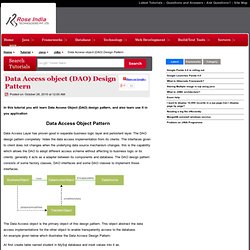
Data access objects. Data Access Objects (DAOs): can be used in a large percentage of applications - anywhere data storage is required.hide all details of data storage from the rest of the application.act as an intermediary between your application and the database.
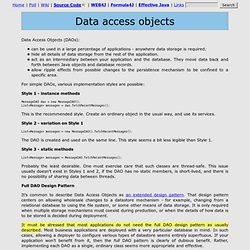
They move data back and forth between Java objects and database records. allow ripple effects from possible changes to the persistence mechanism to be confined to a specific area. For simple DAOs, various implementation styles are possible: Style 1 - instance methods MessageDAO dao = new MessageDAO();List<Message> messages = dao.fetchRecentMessages(); This is the recommended style. Style 2 - variation on Style 1 List<Message> messages = new MessageDAO().fetchRecentMessages(); The DAO is created and used on the same line. Style 3 - static methods List<Message> messages = MessageDAO.fetchRecentMessages(); Probably the least desirable.